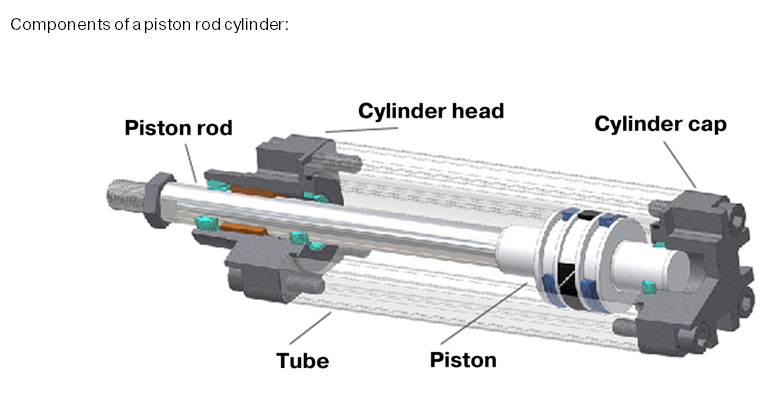There are so many pneumatic valves, do you know the Pneumatic cylinder?
01 Basic structure of air cylinder
The so-called pneumatic actuator is a component that uses compressed air as power and drives the mechanism for linear, swing and rotation motions.
Take the commonly used basic pneumatic cylinder as an example to see what’s inside.
The question is, I don’t know if you look at the picture below, can you tell if it is a single-acting cylinder or a double-acting air cylinder?
China Ck45 Chromed Piston Rod+ Air Cylinder Kit+ Piston+ Aluminum Cylinder Tube
(we are Air Cylinder Tubing Manufacturer)
 02 Classification of pneumatic cylinders
02 Classification of pneumatic cylinders
Single-acting pneumatic cylinder: The piston is supplied with air on only one side, and the air pressure pushes the piston to produce a thrust to extend and return by spring or its own weight.
Double acting air cylinder:
There is air pressure on both sides of the cylinder piston to realize forward or backward movement.
03 air Cylinder cushion
However, the pneumatic cylinder also has a problem. If the cushioning device is not used, when the piston moves to the end, especially the cylinder with long stroke and fast speed, the kinetic energy of the piston hitting the end cover will be very large, which can easily damage the parts and shorten the life of the cylinder. .
What’s more, the noise caused by the impact is also terrible. If the noise of a pneumatic cylinder without a buffer device is 70dB, the noise of the entire factory will be as high as 140dB, just like being on the runway of a jet airplane for a long time. This has reached the limit that human beings can’t stand and suffer.
How to solve these problems?
Our designers made a cushion design for the pneumatic cylinder.
Hydraulic buffer:
The first and simplest method for pneumatic cylinder cushioning: install a hydraulic cushion at the front end of the cylinder.
The working principle diagram of hydraulic buffer is as follows:
Through the unique orifice design, mineral oil is used as the medium to smoothly realize the transition from high speed and light load to low speed and heavy load.
Features: There is no need to adjust the wide range from small energy to large capacity, and the best energy absorption can be achieved.
Rubber buffer:
In order to install more compactly in the factory, the designers thought of another method, the second method: rubber cushioning. (Cushion pads are set on both ends of the piston rod)
Precautions:
1) The cushioning capacity is fixed and immutable, and the cushioning capacity is small. It is mostly used for small cylinders to prevent operating noise.
2) It is necessary to pay attention to the phenomenon of deformation and peeling caused by the aging of the rubber.
Air cushion:
The third method: air cushioning. (When the piston moves, the buffer sleeve and the sealing ring work together to form a closed air chamber/buffer cavity on one side to achieve buffering.)
The gas in the buffer chamber can only be discharged through the buffer valve. When the opening of the cushion valve is very small, the pressure in the cavity rises rapidly, and this pressure produces a reaction force on the piston, thereby decelerating the piston until it stops.
Precautions:
1) By adjusting the opening of the buffer valve, the buffer capacity can be adjusted. The smaller the opening, the greater the cushioning force.
2) Use the back pressure when the cylinder is operating to achieve cushioning. The cylinder back pressure is small. The buffer capacity will also become smaller. When using, pay attention to the control method of load rate and cylinder speed.
04 Magnetic switch
Speaking of this, we know how the cylinder moves freely. But everything has rules, and so does the movement of the cylinders. Have they all run into position? Have they crossed the boundary? Who should supervise this?
Magnetic switch-it is a feedback signal to judge whether the cylinder is running in place, and controls the corresponding solenoid valve to complete the switching action.
Principle: The magnetic ring that moves with the piston approaches or leaves the switch, and the reeds in the switch are magnetized to attract or disconnect each other, sending out electrical signals.
Features: There is no need to install a machine-controlled valve and its mounting frame at both ends of the cylinder stroke, and no need to install a bumper at the end of the piston rod, so it is convenient to use, compact in structure, high in reliability, long in life, low in cost, and fast in switching response time. , Has been widely used.
05
Cylinder lubrication
In addition, we also want to talk about lubrication, the purpose of which is to reduce the damage of the cylinder movement to the cylinder itself and prolong the service life of the cylinder.
Lubricate oil:
Use a lubricator to mix lubricating oil into compressed air and deliver it to the cylinder.
Non-lubricating oil:
Only use built-in grease, no need to use lubricator for lubrication; to avoid contamination of food and packaging by oil particles during the transportation process, influence on the properties of certain industrial chemical pigments, or influence on the accuracy of testing instruments, etc. At present, most manufacturers have fully realized non-fuel cylinders.
Precautions:
Once it is used to lubricate the oil, it needs to be used continuously. Once stopped, the life expectancy drops sharply.
Post time: Dec-10-2021



